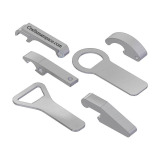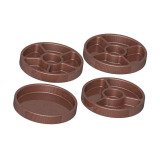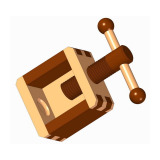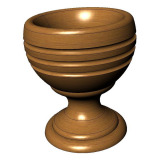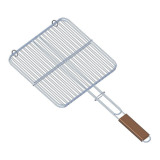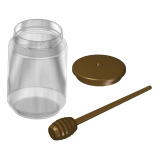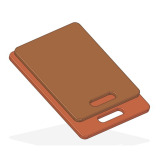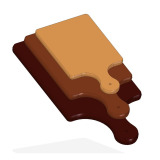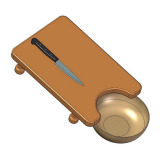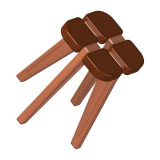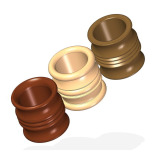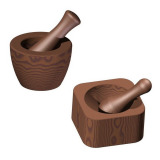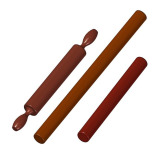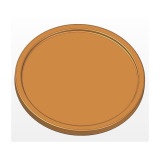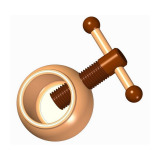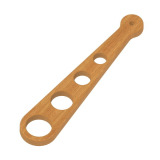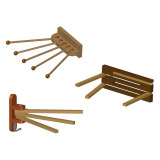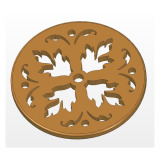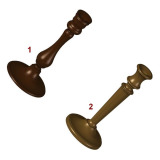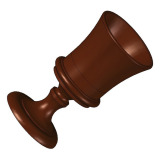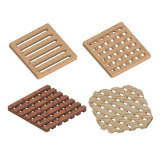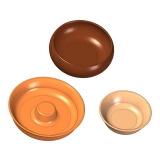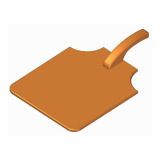There are a number of kitchen utensils you can make yourselves of wood or metal; this category of projects can make the job a lot easier or give you helpful ideas.
Wooden kitchen utensils were used since ancient times, when people began to make the first tools. Archaeological evidence of a wooden spoon use came from ancient Egypt, the first forks came from ancient Greece, and bamboo Chopsticks had been used in China 5000 years ago. Ancient Romans expanded the use of wooden kitchen utensils across the Europe and The Middle East, and they had also been used by Native Americans at the time of the first settlers’ arrival. In the beginning, kitchen utensils were made of wood, because wood was easily accessible and processed material, and later on, when people began to make kitchen utensils of metal, wooden utensils had become a hallmark of poverty.
Today, market offers us very wide range of kitchen utensils, with very wide selection of materials, designs, quality and purpose. When purchasing, we are lead primarily by the fact why we need utensil for, and after that by price, quality and design. The most used materials for kitchen utensils production are wood, stainless steel, ceramics, glass, plastic and many others. We often can see utensils made of inadequate materials, both from healthy and practical aspect - aspect of use. Whether you cook every day or only occasionally, that moment when kitchen utensils are used, it becomes evident whether they beside esthetic value have also practical value.
Here you can find plans for several simple bottle openers designed like key fobs, so you can easily add the key ring and make practical key tag.
Plan for making wooden appetizer set includes one wooden snack plate and three variants of chip and dip bowls.
With the free woodworking plan that you can download on this page you can make a Decorative wooden nutcracker, a perfect craft fair item to sell.
If you want to make a wooden egg cup (egg server) like the one in the picture, here you are given a 3D model and a free plan with all the necessary dimensions.
By our plan you can make a Grilling basket, practical barbecue tool and a a perfect gift for yourself or anyone who loves grilling.
Here we present to you a plan for a wooden honey dipper and an accompanying wooden honey jar lid.
We offer the plan for a very simple kitchen chopping board in two sizes. This plan is just an idea, and you can adjust the dimensions to your needs.
We are presenting you plan for the Classic wooden kitchen cutting board that you can make very quickly and it will last for years.
This Slicing platform plan will help you to make functional and practical cutting board on legs.
With this plan you can make a multi-purpose kitchen stool, a practical addition to your kitchen.
Napkin ring is a circular band used to hold a particular person's napkin neatly before a meal begins. We are offering the plan for wooden napkin ring in several variations.
On this page you can download plan that can help you make pestle and mortar (two versions), a perfect gift for anyone who loves cooking.
We are offering you the plans for several types of rolling pins: Bakers rolling pin, Pastry rolling pin and Tortilla rolling pin.
We offer the plan for the Round Wooden bread board. The plan is simple, so you can easily customize the dimensions of this wooden breadboard to suit your needs.
We are offering you the plan of wooden nut cracker which is a simple tool consisting of rounded body and handle with threaded axle.
With the plan that you can download on this page you can make a Spaghetti measuring tool, a perfect pasta-portioning tool.
On this page you can download three woodworking plans by which you can easily make towel racks that are functional, and most importantly, they fold and take up very little space when not in use.
We offer the plan for the round wooden trivet with scroll saw pattern. You can cut the pattern with the scroll saw technique or with the laser cutter
Here you can dowload a 3D model and a free woodturning plan for the making of a wooden candle holder.
On this page you can download the 3D models and 2D drawings of two wooden candlesticks.
On this page you can download "do it yourself" woodturning project (and 3D model) for the making of a turned wooden goblet.
All four wooden trivets proposed here are made of a single piece of wood. It is so called "waffle pattern trivets," that is, lattice design, and it is quite easy to make.
We are offering you the wooden bowl plans for several different models of the nut bowls, a perfect craft fair items to sell.
Here we offer the plan for the wooden cheese board with very nice and simple design. Board has a wooden handle, so it is very convenient for catering and serving.
Wood is often used for kitchen utensils production, because for some utensils, beside tradition, it has numerous advantages compared to the other materials. Compared to plastic, wood is firm, it won’t melt when it comes in touch with hot dishes and it is natural. Unlike metal utensils, wood won’t scratch the most delicate cooking surfaces and it does not conduct the heat. Some kitchen utensils are always made of wood, because of both traditional and practical reasons. This type of utensils are, for example, ladle, cutting boards, rolling pins, trivets and meat hammer. There are numerous other utensils made of wood, such as fruit bowls, salad forks, serving spoons, spatula, spice boxes, bread boxes, pestle and mortar, spoons…
For kitchen utensils production we can use different types of wood, but the fact is that wood should be hard, so that kitchen utensils could be more durable. Wood with large pores should be avoided, because pores would keep food particles which will enable bacterial development. Recommended wood types are orchard woods like apple or pear wood and also olive, maple, cottonwood, basswood, beech, birch, cherry, hornbeam, hickory, Osage orange, bamboo and many others. Wood types we should avoid are most of softwoods, because they contain resins that can discharge into food and give it an undesirable taste. Some types, such as Oak or Black walnut, contain high tannin content and they can turn black when they come in contact with some food type. We should also avoid most tropical hardwoods, because some of them contain substances that can be dangerous or cause allergic reactions, and a huge number of tropical wood species don’t always come from managed sources and so, with the purchase, you maybe encourage unwillingly destruction of tropical rainforests. Wood types you should never use are those that are proven to be poisonous or have this reputation, such as, for example, Poison Ivy vine, or those that cause allergic reactions.
Maintaining wooden utensils is easy if few rules are followed: They should be washed by hand, with hot water and mild detergent, and after that, dry them well. Never leave them in the water for too long and they should not be washed in a dishwasher. If maintained properly, they will last long and won’t get damaged. Plastics industry claims that using of wood is not safe because it can keep bacteria, and many people tend to believe that claim, but science has proven that’s not true. It was confirmed that wood has more antibacterial features than any material made by human. Of course, this applies if you maintain them properly. If you leave utensils dirty, the dirt will grow bacteria regardless material utensils are made of. There are numerous discussions on how to protect and maintain wooden kitchen utensils. Most often you will find recommendation that they should be occasionally wiped with a napkin soaked in food-safe mineral oil, and note that for this purpose should not be used vegetable oils, such as, for example, Olive oil, because they will go rancid which can lead to stomach problems. Opposing arguments again suggest that mineral oils (paraffin oils) are not natural, and that should be used natural oils which need longer period of time to go rancid, compared to Olive oil. Mentioned oil of that type is Coconut oil that also has antibacterial and antiviral features. Because of these conflicting claims, we will not suggest you how to protect your wooden kitchen utensils. We will mention our observations: in contact with food, wooden utensils come in contact with fats, so you should consider whether the additional coating is necessary. Utensils that exclusively come in contact with food that’s not fatty (for example, spoon for flour) are not exposed to frequent wetting and therefore they can last long without any protection. Our family for generations uses wooden kitchen utensils without any additional coating, and the only maintaining is washing them after use, good drying and keeping them in the dry place, and they will last for years. We change them when we want to treat ourselves with new utensils, and not because wood is damaged due to poor maintenance.
Wooden kitchen utensils can not be easily found and purchased in the stores that surround us, and even if we find them there, selection is very poor, and we are not sure of what type of wood they are made of. Because of that, we offer plans for wooden cutting boards, bread boards, wooden scoops, wooden trivets, pestle and mortar, wooden nutcrackers, rolling pin, wooden bowls and others. They mainly belong to the group Preparation and serving equipment. When you make kitchen utensils by yourself, you are sure of type and quality of wood you’re using, quality of production, you can customize dimensions that suit you the most and you decide whether to leave wood natural and what type of finishing to use.
